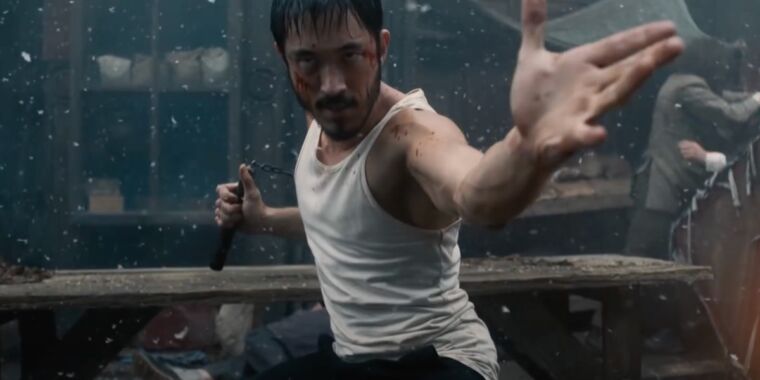All-out war breaks out in San Francisco’s Chinatown in Warrior S2 finale
[ad_1]
Andrew Koji returns as Ah Sahm, a Chinese martial arts expert embroiled in the Tong Wars and other conflicts in 19th century San Francisco in Warrior, now airing on Cinemax.
Martial arts period drama Warrior, inspired by the writings of Bruce Lee, wraps up its second season tonight on Cinemax as all-out war breaks out between the Chinese tongs and the Irish mob in 19th century San Francisco’s Chinatown. We sat down with showrunner Jonathan Tropper (Banshee) to learn more about this action-packed season, a hero’s journey, and what kind of future Warrior might have going forward.
(Spoilers for season 1 below; only very mild spoilers for season 2.)
Warrior follows a young Chinese martial arts prodigy, Ah Sahm (Andrew Koji, Fast and Furious 6), who arrives in 19th-century San Francisco to look for his long-lost sister. He soon finds himself embroiled in the Tong Wars, a period of particularly violent disputes between rival Chinese gangs, called tongs, in the Chinatowns of several American cities. Ah Sahm also must contend with rising anti-immigrant sentiment against the Chinese and a forbidden interracial romance.
There are opportunists like Wang Chao (Hoon Lee, Banshee, Iron Fist) who seek to play both sides, deliberately fostering hostility between the tongs for fun and profit. Chao and Mai Ling (Dianne Doan, Vikings), Ah Sahm’s estranged sister, want to sow chaos to gain wealth and power. On top of all that, there is no love lost between the Chinese immigrants and the Irish working class, who are competing for the same backbreaking jobs in an increasingly tight economy.
In 1971, Bruce Lee pitched an idea for a TV series about a martial artist in the Old West. Skittish studio heads passed on the project (and on Lee as its star), opting to make Kung Fu with David Carradine instead. When Lee’s daughter, Shannon Lee, took over management of her father’s legacy in 2000, among the archived materials was Lee’s original treatment, along with several drafts and notes. Shanon Lee mentioned its existence to executive producer Justin Lin (The Fast and the Furious: Tokyo Drift). Lin loved the treatment and thought they could make the series that her father had always intended. Cinemax brought Tropper on board as creator and executive producer. Tropper was a Bruce Lee uber-fan, so he jumped at the chance to work on the project.
A hero’s journey
In S1, Ah Sahm joined up with the Hop Wei tong and became BFFs with Young Jun (Jason Tobin, Fast and the Furious: Tokyo Drift), son to the tong leader. He had an indiscreet affair with Penelope (Joanna Vanderham, Legends of Tomorrow), the (white) wife of Mayor Samuel Blake (Christian McKay, The Theory of Everything), and discovered that his long-lost sister, Mai Ling, was not the innocent in need of saving he’d assumed. Rather, she was angling to become the head of the rival Long Zii tong—and she succeeded. As violence between the tongs escalated into an all-out turf war over the Chinatown opium trade, Ah Sahm fought mano a mano with a Long Zii champion, Li Yong (Joe Taslim, The Raid, Fast and Furious 6), over who would gain majority control over the opium trade. Ah Sahm suffered a humiliating defeat and was kicked out of his tong for his failure.
Even though the Long Zii were victorious, in the finale, Mai Ling was forced to renegotiate her uneasy alliance with Zing (Dustin Nguyen, 21 Jump Street, Little Fish), leader of the Fung Hai tong, for a bigger share of the opium trade. Ah Sahm worked through his humiliation by beating up a gang of racist Irish thugs and ultimately rejoined the Hop Wei.
In S2, Ah Sahm has begun spending his nights competing in an underground fight club to further hone his martial arts skills—clearly still smarting from his loss to Li Yong. He has a new love interest in the fight club manager, Rosalie Vega (Maria Elena Laas, Vida), and faces a new anti-immigrant hate group known as the Teddy Boys. Meanwhile, a vigilante swordsman is roaming the streets at night, exacting vengeance, and Mai Ling discovers it’s not an easy job running a tong, as she finds it difficult to control her uber-violent ally, Zing. And the Irish mob has declared outright war on Chinatown, with multiple casualties on both sides, as we head into tonight’s season finale.
-
Ah Sahm (Andrew Koji) over-compensates for his crushing S1 defeat by joining an underground fight club.
YouTube/Cinemax -
That didn’t take long.
YouTube/Cinemax -
Young Jun (Jason Tobin) remains loyal to his Hop Wei tong—and to Ah Sahm.
YouTube/Cinemax -
Ah Sahm’s sister, Mai Ling (Diane Doan), has gained control over the rival Long Zii tong.
YouTube/Cinemax -
That’s what I call making an entrance.
YouTube/Cinemax -
Meanwhile, brothel madame Ah Toy (Olivia Cheng) moonlights as a vigilante.
YouTube/Cinemax -
Zing (Dustin Nguyen) is the new leader of the Fung Hai tong, and an ally to Mai Ling.
YouTube/Cinemax -
Officer “Big Bill” O’Hara (Kiernan Bew) has a bit of a gambling problem.
YouTube/Cinemax -
Senator Crestwood (Patrick Baladi) is looking to boost anti-immigrant sentiment to bolster his presidential ambitions.
YouTube/Cinemax -
Dylan Leary (Dean Jagger), crime lord of the Irish Mob, is open to that message.
YouTube/Cinemax -
The mayor’s wife, Penelope (Joanna Vanderham), had an ill-advised affair with Ah Sahm and now feels used.
YouTube/Cinemax -
Walter Frankin Buckley is secretly conspiring with Mai Ling to start a war between the Hop Wei and the Long Zii.
YouTube/Cinemax -
Cornered and itching for a fight.
YouTube/Cinemax -
Finish him!
YouTube/Cinemax -
Nellie Davenport (Miranda Raison) is an activist on behalf of Chinese immigrants.
YouTube/Cinemax -
Wang Chao (Hoon Lee) finds out that being the middleman has its risks.
YouTube/Cinemax -
The fighting Irish march into battle.
YouTube/Cinemax -
The classic warrior stance.
YouTube/Cinemax
Ars Technica: In S2, we see Ah Sahm still struggling to bounce back from the devastating loss he suffered at the end of S1. How do you see this in terms of his overall character arc? Why was it so significant that he lost that one fight?
Jonathan Tropper: It was significant for two reasons. From an emotional standpoint, it now pits him firmly against his sister. He saw that his sister was ready to sacrifice him for her tong and that has broken his heart and also enraged him. At the same time, from a character perspective, Ah Sahm spent the first episode [in S1] fresh off the boat trying to figure his life out: who’s friend, who’s foe, how does he survive here. His vector in S2 is much more driven. He wants revenge, he wants to reclaim his own sense of invulnerability. He wants to avenge his loss, but he also wants to take his sister down. What’s motivating him now is a seething anger and a sense of failure that makes him much more volatile and much more driven to make the tongs answer for what happened to him. So it gives us a much more energized and activated Ah Sahm.
Ars Technica: I noted last year that the women in the series are pretty strong in their own right, despite the fact that this was a period when women couldn’t own property and certainly couldn’t vote. You’re bringing a bit of a 21st century sensibility to the series, but you still need to be true to the period. How do you strike that balance?
Tropper: It’s a tricky balance even beyond the women. First of all, not having been alive in 1878, I have to believe that even in this period where women weren’t able to do certain things, there were still women who found ways to be powerful. Women wouldn’t be where they are today if there weren’t powerful women back then starting to pull strings. Beyond that, a larger challenge was that we did not want to create a docudrama. We weren’t interested in creating a factual San Francisco Chinatown. That’s very evident in our production design and in our costume design. We wanted to create our own version of this world, a heightened, almost graphic novel version. That freed us up to take certain liberties to make the show feel very contemporary in an artful way. The Hop Wei gangsters wear suits cut like Armani suits. Nobody cut suits like that in the 1870s.
The way people talk to each other is a bit different. We don’t embrace a lot of period speak in the show. We’re trying to create our own vernacular, our own sense of architecture for this world—an emotional and visual representation of 1870s San Francisco, without having to actually create a true 1870s San Francisco. This world has to live a little bit in the world of Bruce Lee. And you can’t have people getting into Goku fights all over the place and still [be historically accurate].
Ars Technica: The fight choreography is once again truly extraordinary. Last year, we talked about the various different styles that were used that suit the various characters. What was your approach to the fight choreography coming into S2?
Tropper: They told us to bring back the A-team. Bring back Justin and Johnny Yang. Those guys have such a strong understanding not only of martial arts, but of Bruce Lee. They also intuitively understood the kind of fighting we wanted on the show. We didn’t want artful balletic kung fu. We wanted much more of a street fighting nature to it, although we did want to capture the beauty of it. It has to be rough, it has to be violent, it has to be nasty. It can’t look like beautifully choreographed martial arts. My job is to make sure that every fight is telling a story and servicing the characters involved. Their job is to take that and just make it look really good.
Ars Technica: Why did you decide to develop the character of Zing further for S2? What does he add to the mix?
Tropper: It was always our intention when we brought him in for S1. I was a fan of Dustin Nguyen, ever since 21 Jump Street. But I was also familiar with the work he had done both as a director and an actor in Vietnam. I thought he was a tremendous addition to the show. We had these two tongs going to war against each other, but they seem to always follow the same rules in Chinatown. I wanted to introduce a spoiler, a third tong that’s much more violent and savage, one that isn’t pitting brother against sister, so it has nothing invested in that struggle. This spoiler tong can come in and ruin it for both of them, because Zing has got his own agenda. But ultimately we were serving a single story of the Chinese American immigrant experience, while honoring and celebrating this vision that Bruce Lee had 60 years ago.
Ars Technica: The anti-immigration sentiment has been an integral part of the series from the beginning, and these issues seem particularly timely right now.
Tropper: I’ll tell you what’s interesting. When I created this show, I was just honoring Bruce Lee’s mission, because he was very conscious of this 60 years ago. Then the [current] administration came in and immigration issues became more relevant. Certainly [with the pandemic], anti-Asian sentiments have crept back in. But having gotten to know a lot of the actors on the show—this is the kind of show that, when you’re sitting on set, the actors will share their personal experiences with you, and this is something that obviously was meaningful to all of them. This has never not been an issue. They’ve been experiencing this their whole lives.
Ars Technica: How are we going to see this world open up further, hopefully in a third season? The tong wars was a broad period, so you must keep discovering new stories to explore.
Tropper: If we have the opportunity, we could keep going. Every year we continue to deep-dive into the history and find little bits of history that inspire plot lines. For instance, in S2, the character of Nellie Davenport is based on a real character named Donaldina Cameron. We always find things to inspire us and I hope we would continue to do that. But I’m not sure given the current situation with our home network that it’s going to happen. [Editor’s Note: Cinemax is no longer investing in original programming, so the hope is that another network will pick up the series.] I’m just really proud of this season. I think it’s more ambitious, it’s more complex, and it’s more explosive than S1. It’s a great continuation of the story.
The S2 finale of Warrior debuts tonight at 10pm on Cinemax. All prior episodes are available for streaming to Cinemax subscribers, and S1 can also be purchased on Amazon Prime.
Listing image by YouTube/Cinemax
[ad_2]
Source link




